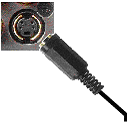在改章节中,我们主要介绍参考知识的内容,自我感觉有个不错的建议和大家分享下
还是老外说的其实,图文并茂的,不明白都不行:
| |
[Tech : video ] Content 2004 by Lyberty; last updated March 30, 2005
 S-Video (Separated-Video) is better than a composite video connection. S-Video (Separated-Video) is better than a composite video connection.
But note that the bandwidth of S-video (also written as "S Video") is the same as that of composite video. The real benefit of an S-video connection is that it can reduce dot crawl, hanging dots, and crawling edges that appear on the vertical and horizontal edges (respectively) of some colored objects in the picture. [more]
S VIDEO, originally known as "Y/C Separated video", is one of the higher quality ways to transmit the television signal from a peripheral device (DVD player, PlayStation 2, whatever) to a television. The way S-Video works is that it basically separates the color information (Chrominance) from the brightness (Luminance). By doing this, it reduces things like color bleeding and dot crawl and greatly increases the general clarity and sharpness of the picture. The reason that this is so is that televisions are designed to display separate Luminance (Y) and Chrominance (C) signals.
S-Video connector pin-out:

Recommendation: The increase in picture quality that you'll get in platform games (like the PS2) when you move from composite (yellow-plug) to S-Video is very noticeable and is well worth spending the extra money to buy the optional cable.
 Component (not composite) Video [aka Analog Component Video; Y - Pb - Pr; red-green-blue]: Component (not composite) Video [aka Analog Component Video; Y - Pb - Pr; red-green-blue]:
Uses a three jack cluster of wires with the ends color coded green, blue, and red. (does not include audio cable).
Y-Pb-Pr, or what we nowadays refer to as component video or color difference video, was invented to simplify video electronics and reduce the overall bandwidth requirements for transmitting video compared with RGB. In practice it provides one luminance signal with full horizontal resolution and two color signals with reduced horizontal resolution.
Y = Luminance, Pb = Chrominance 1, Pr = Chrominance 2
From your DVD player or HDTV set top box to your TV, it is analog, thus its full name "analog component video".
Also referred to as Y, R-Y, B-Y or color difference video. Some DVD players label the green, blue, and red jacks Y, Cb, Cr .
 Composite Video [RCA or BNC] (aka "yellow-plug" video) Composite Video [RCA or BNC] (aka "yellow-plug" video)
The old "AV" standard connector. The common RCA connector is color-coded Yellow for Composite video.
The term "yellow-plug video" is recommended to help cut down on confusion between "composite" and "component" (which sound alike).
SUMMARY:
The four types of standard video connections described in the following table give you four levels of video quality. Optimize your viewing experience by using the best connection available for your connected component. For example, if your DVD player supports a component video connection, connect the DVD player to your Plasma TV using component video instead of composite video or S-Video.
| Quality |
Cable and Connector |
Connection Description |
| Best |
 |
Component - The video signal is split into three signals, two color and one black and white, giving you the best picture. Use component video to take advantage of the superior picture found in such signal sources as HDTV and progressive DVD. |
| Better |
 |
S-Video - The video signal is split into two signals, giving you an even better quality picture. For example, text displayed on-screen using this connection is noticeably sharper than composite or coaxial (RF). |
| Good |
 |
Composite ("yellow plug") - The video signal is carried through a single "pin". This connection type is the one that is most commonly found on video devices (as of 2004/2005). |
| Basic |
 |
Coaxial (RF) - The video and audio signals are both carried in one cable. Used for antenna and cable signals.
(The other three connection types only handle video, requiring separate connections for sound.) |
But what about those red and white connectors?
 Audio Inputs Audio Inputs
Stereo Analog Audio connections use red and White color coded "RCA" connections. These support mono or stereo analog audio.
Building a home theatre: Get a 27" or bigger TV with a component video input.
The only feature you should shop for when buying this TV is a component input (in addition to composite and s-video). This input is about 1/2 an inch in diameter with about five pins in the center.
Component video comes in different non-interchangeable formats (scan rate formats) for regular TV or HDTV, for example:
>>>>>>>>>>>>> Interlaced or 480i from a standard NTSC DVD player : : 480i = NTSC interlaced video = 640x480 pixels = 480 displayed horizontal lines of resolution
>>>>>>>>>>>>> 480p from a progressive scan NTSC DVD player : : 480p = NTSC progressive scan = 640x480 pixels = 480 displayed horizontal lines of resolution
>>>>>>>>>>>>> 720p (HDTV) :: 720 displayed horizontal lines of resolution
>>>>>>>>>>>>> 1080i (HDTV) :: 1080 displayed horizontal lines of resolution
Note: Typically, standard TVs and HDTVs support only a 60Hz refresh rate.
Component or s-video? ( vs.)
S-Video: separates chrominance and luminance
Component: further separates chrominance into two signals
This is why component is better. Makes a big difference even on an analog tv when using a dvd player.
Recomendation: Use high quality cables. Gold plated, double shielded, and made for video only.
Note: If your DVD player does not have a progressive scan (480p) button then the signal will be 480i.
|
每日一道理
冰心说道:“爱在左,同情在右,走在生命的两旁,随时撒种,随时开花,将这一径长途,点缀得香花弥漫,使穿枝拂叶的行人,踏着荆棘,不觉得痛苦,有泪可落,却不是悲凉。”
其他知识可参考:http://www.lyberty.com/encyc/articles/svideo.html
文章结束给大家分享下程序员的一些笑话语录:
N多年前,JohnHein博士的一项研究表明:Mac用户平均IQ要比PC用户低15%。超过6000多的参加者接受了测试,结果清晰的显示IQ比较低的人会倾向于使用Mac。Mac用户只答对了基础问题的75%,而PC用户却高达83%。
 S-Video (Separated-Video) is
S-Video (Separated-Video) is 
 Component (not composite) Video [aka Analog Component Video; Y - Pb - Pr; red-green-blue]:
Component (not composite) Video [aka Analog Component Video; Y - Pb - Pr; red-green-blue]:



 Audio Inputs
Audio Inputs